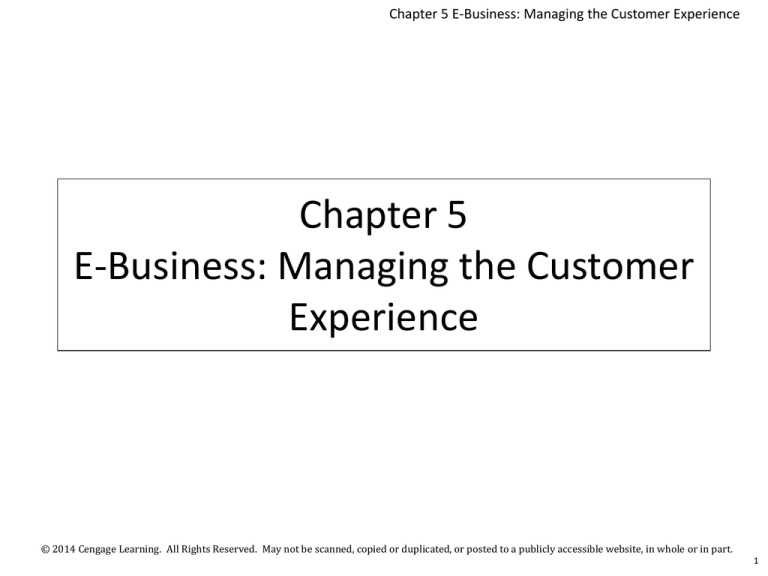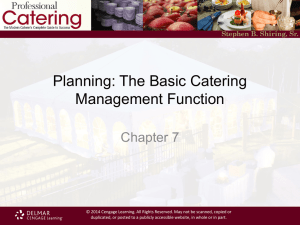
Chapter 5 E-Business: Managing the Customer Experience
Chapter 5
E-Business: Managing the Customer
Experience
© 2014 Cengage Learning. All Rights Reserved. May not be scanned, copied or duplicated, or posted to a publicly accessible website, in whole or in part.
1
Chapter 5 E-Business: Managing the Customer Experience
Objectives
1. Describe the growth of Internet use worldwide.
2. Define e-business and e-marketing, and list the
opportunities e-marketing presents.
3. Distinguish between a corporate website and a
marketing website.
4. List the major forms of B2B e-marketing.
5. Explain business-to-consumer (B2C) e-marketing.
© 2014 Cengage Learning. All Rights Reserved. May not be scanned, copied or duplicated, or posted to a publicly accessible website, in whole or in part.
2
Chapter 5 E-Business: Managing the Customer Experience
Objectives
6. Identify online buyers and sellers.
7. Describe some of the challenges associated
with online marketing and e-business.
8. Discuss how marketers use the communication
function of the Web as part of their online
marketing strategies.
9. Outline the steps involved in developing
successful e-business websites and identify
methods for assessing website effectiveness.
© 2014 Cengage Learning. All Rights Reserved. May not be scanned, copied or duplicated, or posted to a publicly accessible website, in whole or in part.
3
Chapter 5 E-Business: Managing the Customer Experience
The Digital World
• More than three-quarters of the U.S. population
access the Internet
• What do people do online?
– United States – Communication, information, and
purchases
– China – Downloading, streaming music, online
gaming, videogaming, and social networking
• The benefits and potential of e-business
outweigh the concerns and problems
© 2014 Cengage Learning. All Rights Reserved. May not be scanned, copied or duplicated, or posted to a publicly accessible website, in whole or in part.
4
Chapter 5 E-Business: Managing the Customer Experience
E-Business
• Wide range of business activities that take place via
Internet applications
• It can be divided into five broad categories:
– E-tailing
– Business-to-business transactions
– Electronic data interchanges (EDI)
– Email, instant messaging, blogs, podcasts, vlogs (video blogs),
and other Web-enabled communication tools
– The gathering and use of demographic, product, and other
information through Web contacts
© 2014 Cengage Learning. All Rights Reserved. May not be scanned, copied or duplicated, or posted to a publicly accessible website, in whole or in part.
5
Chapter 5 E-Business: Managing the Customer Experience
E-Marketing
• Strategic process of creating, distributing,
promoting, and pricing goods and services to a
target market over the Internet or through digital
tools
• Has the potential to:
– Greatly reduce costs
– Increase customer satisfaction
• Online marketing - Activities that connect buyers
and sellers electronically through interactive
computer systems
© 2014 Cengage Learning. All Rights Reserved. May not be scanned, copied or duplicated, or posted to a publicly accessible website, in whole or in part.
6
Chapter 5 E-Business: Managing the Customer Experience
Table 5.1 - E-Marketing Capabilities
© 2014 Cengage Learning. All Rights Reserved. May not be scanned, copied or duplicated, or posted to a publicly accessible website, in whole or in part.
7
Chapter 5 E-Business: Managing the Customer Experience
Web Business Models
• Corporate website - Designed to increase a
firm’s visibility, promote its offerings, and
provide information to interested parties
– Build customer goodwill
– Assist channel members in their marketing efforts
• Marketing website - Main purpose is to
increase purchases by visitors
© 2014 Cengage Learning. All Rights Reserved. May not be scanned, copied or duplicated, or posted to a publicly accessible website, in whole or in part.
8
Chapter 5 E-Business: Managing the Customer Experience
B2B E-Marketing
• Use of the Internet for business transactions
between organizations
• Tools used:
– EDI
– Web services
– Extranets
– Private exchanges
– Electronic exchanges
– E-procurement
© 2014 Cengage Learning. All Rights Reserved. May not be scanned, copied or duplicated, or posted to a publicly accessible website, in whole or in part.
9
Chapter 5 E-Business: Managing the Customer Experience
E-procurement on Open Exchanges
• E-Procurement - Use of the Internet to solicit
bids and purchase goods and services from
suppliers
– Offers benefits to the public sector
© 2014 Cengage Learning. All Rights Reserved. May not be scanned, copied or duplicated, or posted to a publicly accessible website, in whole or in part.
10
Chapter 5 E-Business: Managing the Customer Experience
B2C E-Marketing
• Selling directly to consumers over the Internet
– Also called e-tailing
– Driven by convenience and improved security for
transmitting financial information
– Service providers are important participants in etailing
© 2014 Cengage Learning. All Rights Reserved. May not be scanned, copied or duplicated, or posted to a publicly accessible website, in whole or in part.
11
Chapter 5 E-Business: Managing the Customer Experience
Electronic Storefronts
• Company website that sells products to
customers
• Items for purchase are placed in an electronic
shopping cart
– Electronic shopping cart - File that holds items the
online shopper has chosen to buy
© 2014 Cengage Learning. All Rights Reserved. May not be scanned, copied or duplicated, or posted to a publicly accessible website, in whole or in part.
12
Chapter 5 E-Business: Managing the Customer Experience
Benefits of B2C E-Marketing
• Competitive pricing
• Access and convenience
• Personalized service
© 2014 Cengage Learning. All Rights Reserved. May not be scanned, copied or duplicated, or posted to a publicly accessible website, in whole or in part.
13
Chapter 5 E-Business: Managing the Customer Experience
Online Buyers and Sellers
• More than half of all users make at least one
purchase online each month
• Half of all shoppers spend three quarters of
total shopping time doing product research
• Many online shoppers are loyal and buy
mostly from a single site
• Consumers’ online shopping experiences have
been steadily improving in quality and
convenience
© 2014 Cengage Learning. All Rights Reserved. May not be scanned, copied or duplicated, or posted to a publicly accessible website, in whole or in part.
14
Chapter 5 E-Business: Managing the Customer Experience
Challenges in E-Business and EMarketing
•
•
•
•
•
Safety of online payment
Privacy issues
Frauds and scams
Site design and customer service
Channel conflicts and copyright disputes
© 2014 Cengage Learning. All Rights Reserved. May not be scanned, copied or duplicated, or posted to a publicly accessible website, in whole or in part.
15
Chapter 5 E-Business: Managing the Customer Experience
Marketing and Web Communication
• The Internet has four main functions:
– E-business
– Entertainment
– Information
– Communication – Most popular function
© 2014 Cengage Learning. All Rights Reserved. May not be scanned, copied or duplicated, or posted to a publicly accessible website, in whole or in part.
16
Chapter 5 E-Business: Managing the Customer Experience
Marketing and Web Communication
• Online communities and social networks Internet forums, newsgroups, electronic bulletin
boards, and social networks that appeal to
people with common interests
• Blogs and podcasts
– Blog - An online journal for an individual or
organization
– Wikis - A webpage that anyone can edit
– Podcast - Online audio or video file that can be
downloaded to other digital devices
© 2014 Cengage Learning. All Rights Reserved. May not be scanned, copied or duplicated, or posted to a publicly accessible website, in whole or in part.
17
Chapter 5 E-Business: Managing the Customer Experience
Marketing and Web Communication
• Promotions on the web
– Banner ad - Strip message placed in high-visibility areas of
frequently visited websites
– Pop-up ad - Separate window that pops up with an
advertising message
– Preroll video ad - Marketing messages that play before an
online video
– Widget - Tiny interactive applications that Internet users
can copy and add to their own pages to play music, video,
or slide shows
– Search marketing - Paying search engines a fee to make
sure that the company’s listing appears toward the top of
the search results
© 2014 Cengage Learning. All Rights Reserved. May not be scanned, copied or duplicated, or posted to a publicly accessible website, in whole or in part.
18
Chapter 5 E-Business: Managing the Customer Experience
Building an Effective Web Presence
An e-business website can:
• Broaden customer bases
• Provide immediate access
to current catalogs
• Accept and process orders
• Offer personalized customer
service
This requires:
• Developing the site
successfully
• Establishing goals
• Implementing and
determining whether
visitors return to site
• Pricing and maintenance
© 2014 Cengage Learning. All Rights Reserved. May not be scanned, copied or duplicated, or posted to a publicly accessible website, in whole or in part.
19
Chapter 5 E-Business: Managing the Customer Experience
Assessing Site Effectiveness
• Web-to-store shoppers - Consumers who use
the Internet as a tool to aid them at brick-andmortar retailers
• Click-through rate - Percentage of people
presented with a banner ad who click on it
• Conversion rate - Percentage of visitors to a
Web site who make a purchase
• Engagement - Amount of time users spend on
sites
© 2014 Cengage Learning. All Rights Reserved. May not be scanned, copied or duplicated, or posted to a publicly accessible website, in whole or in part.
20
Chapter 5 E-Business: Managing the Customer Experience
Strategic Implications of Marketing in
the 21st Century
• Bright future for marketers who continue to take
advantage of the tremendous potential of ebusiness and e-marketing
• Cutting edge technology of today will be eclipsed
within the next decade by newer technologies
• A marketing evolution for organizations has
occurred
– It embraces Internet technologies as essential parts of
their marketing strategies
© 2014 Cengage Learning. All Rights Reserved. May not be scanned, copied or duplicated, or posted to a publicly accessible website, in whole or in part.
21








